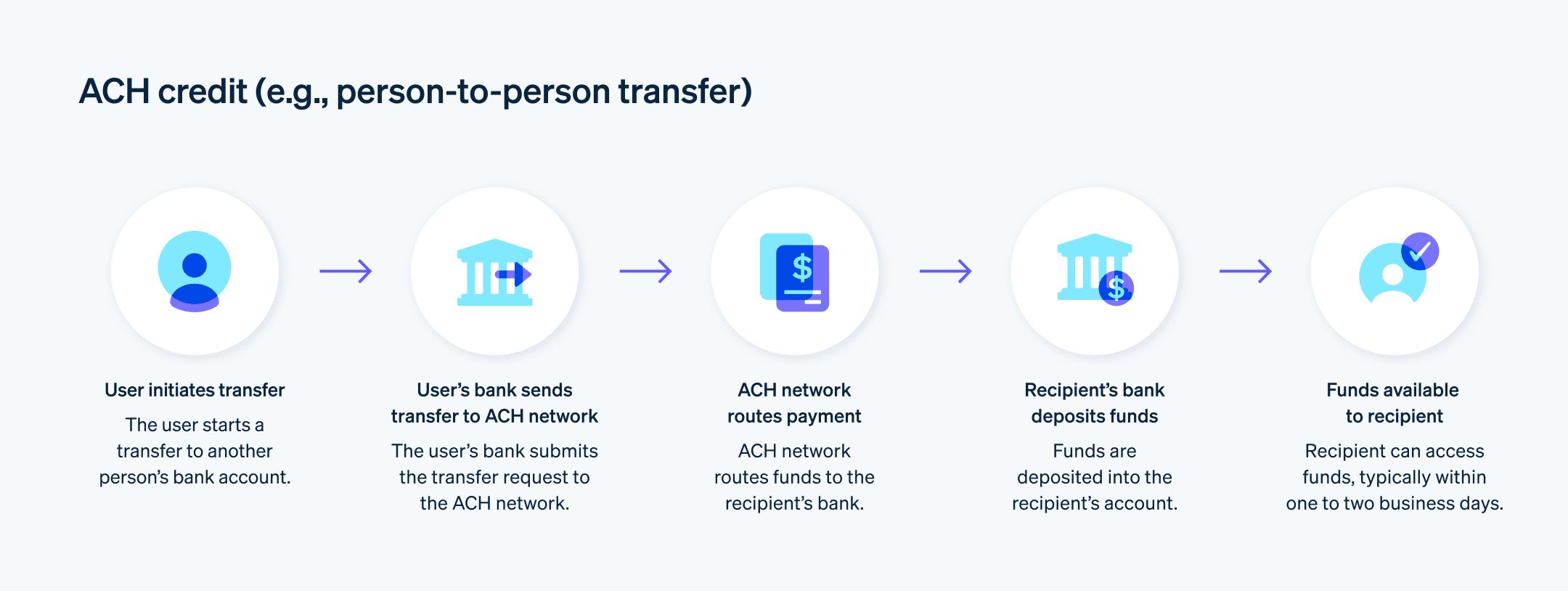银行转账是我们金融生活中的常规部分,但许多人对它们的工作原理了解很少。转账何时到达?费用是多少?作为消费者,您可能没有关注这些问题,但作为企业主,了解作为客户支付方式的接受银行转账的细节是非常重要的。
那么,银行转账对企业来说是如何运作的呢?请看以下概述,了解您需要了解的内容。
目录
- 什么是银行转账?
- 银行转账的类型
- 银行借记转账
- 银行贷记转账
- 银行重定向
- 银行借记转账
- 国内银行转账的类型
- ACH 转账
- 电汇
- ACH 转账
- 国际银行转账网络
- CHAPS
- Bacs
- SEPA
- CHAPS
- 什么是银行识别码 (BIC)?
- 银行转账对企业的好处
- 银行转账对企业的负面影响
- 银行转账安全吗?
- 银行转账需要多长时间?
什么是银行转账?
银行转账是指资金从一个银行账户电子转移到另一个银行账户。“银行转账”是一个广泛的术语,包括许多不同类型的转账和使用方式。
银行转账的类型
银行转账根据两个因素进行分类:操作地点以及用于转移资金的网络。企业通常遇到三种主要类型的银行转账:
银行借记转账
银行借记转账发生在账户持有人授权外部方从他们的银行账户“提取”资金时。资金的转移是由接收方的银行发起,而不是发送方的银行。当客户设置这种类型的银行转账以进行支付时,他们向接收方提供自己的姓名和账户详细信息,接收方随后会使用这些账户信息从发送方的账户中提取资金。
在客户交易中,客户将他们的银行账户信息提供给企业的支付处理商,授权从他们的账户中提取购买金额。


国际银行转账网络
美国与其他国家/地区之间的国际银行转账通常使用 SWIFT(环球同业银行金融电讯协会)网络。SWIFT 成立于 1973 年,连接了 200 多个国家/地区的 11,000 多家银行和金融机构。该网络由 G10 国家(包括比利时、加拿大、法国、德国、意大利、日本、荷兰、瑞典、英国、美国和瑞士)的中央银行管理。
在美国以外的其他国家/地区,各国在其境内进行银行转账时有自己的系统。以下是一些示例:
CHAPS
清算所自动支付系统 (CHAPS) 相当于英国的 ACH。该网络在英国用于处理同日英镑支付。
Bacs
Bacs 是由 16 家顶尖英国银行组成的会员组织。在 2020 年,通过 Bacs 进行了 45 亿笔直接借记支付,约有 20 亿笔直接贷记支付。
SEPA
单一欧元支付区 (SEPA) 是一个综合支付系统,允许欧盟/欧洲经济区和英国的银行账户持有人在不同欧洲银行之间轻松转移资金。
什么是银行识别码 (BIC)?
BIC 用于识别特定银行。在 SWIFT 网络上进行的国际电汇和货币兑换需要 SWIFT 代码,这是一种 BIC。
银行转账对企业的好处
接受银行转账的企业有以下几个关键好处:
无支付撤销或撤单
银行转账最大的好处是客户无法撤回。与信用卡支付不同,后者总是存在撤单风险,银行转账一旦发起,客户无法撤回。
如果客户在通过银行转账付款后对购买不满意,他们必须联系企业并请求退款。这种情况为企业提供了解决问题的最佳机会,并可能避免资金撤回。即使某种情况确实需要退还客户的资金,退款也比撤单更受欢迎;退款使企业对资金撤回过程有更大的控制权。
非常安全
银行转账对于企业及其客户来说通常是非常安全的,而信用卡支付相对更容易受到欺诈风险的影响。
Stripe 为这类支付提供了额外的保护层。Stripe 为其客户提供一个虚拟银行账号,客户将银行转账付款提交到这个号码。这个虚拟账号自动化了对账,并防止企业将真实账户信息暴露给客户。
客户有时更喜欢银行转账
企业通常最好接受尽可能多的支付方式。尤其是银行转账,对于不希望在某些购买中使用信用卡或借记卡的客户来说非常有吸引力。接受的支付类型越多,您可能转化和留住的客户就越多。
欧洲和亚太地区的更高转化率
在欧洲和亚太地区,许多客户交易都是通过银行转账进行的。支持这种支付方式会使您在习惯以这种方式付款的客户中更具吸引力。
银行转账对企业的负面影响
尽管大多数企业发现银行转账是一种可靠、安全、简便的支付接收方式,但它们也并非没有缺点。以下是银行转账的一些缺点:
通常不支持经常性付款
如果您的企业销售订阅或处理经常性付款,这种缺乏支持可能会造成负担或障碍。
对付款金额缺乏控制
由于客户通常发起交易,他们可能会发送错误的金额。虽然有一些解决方案,例如,Stripe 持有客户的银行转账,并允许企业在大多数情况下长达 90 天内对账差异,但您仍需投入额外的时间和资源来处理超额付款或不足付款的问题。
可能存在未完成付款的风险
由于转账流程在不同金融机构之间有所不同,企业很难给客户提供通用的银行转账说明。客户可能认为他们已完成付款,而实际上他们需要联系他们的银行以完成付款。
Stripe 的结账体验在一定程度上缓解了这种风险。但企业仍然面临未完成付款的风险,因为接受银行转账意味着依赖客户完成交易。
延迟的可能性较高
银行转账网络有时会出现处理延迟。根据参与交易的银行,收到的资金可能会面临几天的冻结。国际转账时,冻结和延迟的可能性更大。银行转账网络每年都在变得更加可靠和迅速,但延迟的发生频率仍然比信用卡和借记卡支付更高。
|
Pros |
Cons |
|---|---|
|
No chargebacks: Customers can’t reverse payments |
No recurring payments: Not ideal for subscriptions |
|
More control over refunds: Businesses decide when and how to issue a refund |
No control over payment amount: Customers can send the wrong amount |
|
Highly secure: Lower risk of fraud than card payments |
Possibility of incomplete payments: Confusing process for some customers |
|
Virtual account numbers: Businesses won’t expose their bank details |
Payment delays: Bank processing can take days, especially for international transfers |
|
Preferred by some customers: Appealing especially to those who avoid cards |
|
|
Better conversion in Europe and Asia Pacific: Bank transfers are common in these regions |
银行转账安全吗?
银行转账通常是接受客户付款的非常安全方式,与信用卡支付相比,企业的风险较小。然而,在客户方面,仍然存在电汇欺诈的风险。
银行转账需要多长时间?
无论您将资金发送到哪里,大多数银行转账都会在几天内处理并交付。以下是您可以期待的不同类型银行转账的处理时间,涵盖国内和国际转账:
美元银行转账
在 2021 年 3 月 19 日,Nacha 的操作规则扩展至允许大多数 ACH 交易当天结算。根据 Nacha 的规则,美元银行转账通常在一到两天内交付,而 ACH 借记转账必须在下一个工作日处理并交付。一些银行可能会在 ACH 转账交付后冻结资金几天,但这因金融机构而异。
电汇转账
国内电汇是实时处理的,通常在一个工作日内交付。但如果在周五晚些时候发起电汇,可能要等到下周一才能交付。
国际电汇
美国与其他国家/地区之间的 SWIFT 银行转账通常需要一到五个工作日才能处理和交付。由于对欺诈和洗钱的防范措施增加,这比 ACH 和电汇转账要慢。
本文中的内容仅供一般信息和教育目的,不应被解释为法律或税务建议。Stripe 不保证或担保文章中信息的准确性、完整性、充分性或时效性。您应该寻求在您的司法管辖区获得执业许可的合格律师或会计师的建议,以就您的特定情况提供建议。